BLUET DAMSEL (a lesson in tying an off body fly)
If you’ve never tied an ‘off body fly’ I hope you’ll find this article interesting and informative. I’ve chosen this damsel pattern because it pretty straight forward and one the tier can have a reasonable degree of success with when just starting out. Many of the hex patterns I tie also call for ‘off body tails’ because of the large size of the flies and the pursuit of imitations that look real.
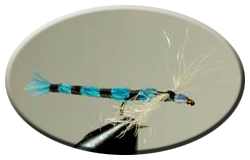
Materials:
Hook: Mustad #94933 Size: #10 Thread: Black, 6/0 Body/Tail: Deer Belly Hair, dyed damsel blue (light blue), segmented with black thread. Wing: Natural Polar Bear Head: Florescent Blue, 6/0
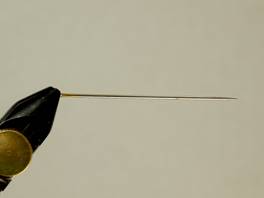 Select a large sewing needle. The one I use as about 2 ¼” long. I retrieved it from my wife’s sewing kit. If you wife doesn’t sew you’ll find them available in most any store that sells fabric or general merchandise. The exact size it not important as long as it’s long. Clamp it in your vise.
Select a large sewing needle. The one I use as about 2 ¼” long. I retrieved it from my wife’s sewing kit. If you wife doesn’t sew you’ll find them available in most any store that sells fabric or general merchandise. The exact size it not important as long as it’s long. Clamp it in your vise.
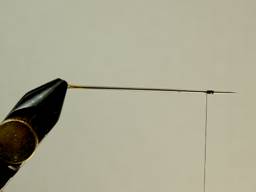 Take your black thread and attach it near the tip of the sewing needle. We want our deer hair to roll or wrap around the needle smoothly and evenly so do not run your thread the whole length of the needle.
Take your black thread and attach it near the tip of the sewing needle. We want our deer hair to roll or wrap around the needle smoothly and evenly so do not run your thread the whole length of the needle.
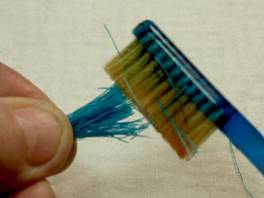 Select about 12-15 dyed deer hairs. They should be about 1 ½” long. They can be longer if you choose --- we’ll trim them off a little later. Clean out the under hair using a hair comb or old tooth brush. Do not place the hair in your hair stacker like you’ve been conditioned to do. When you cut off the hair from the hide the butt ends were even. Keep them that way.
Select about 12-15 dyed deer hairs. They should be about 1 ½” long. They can be longer if you choose --- we’ll trim them off a little later. Clean out the under hair using a hair comb or old tooth brush. Do not place the hair in your hair stacker like you’ve been conditioned to do. When you cut off the hair from the hide the butt ends were even. Keep them that way.
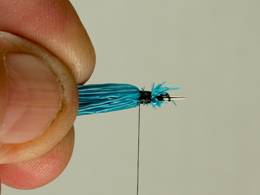 Tie in the deer hair butts near the tip of the sewing needle. Do not trim away too much of the excess material. I call this roughly trimmed end the ‘stump’. We will need this later so that we can attach it to the shank of the hook. Wrap a length of thread about 1/8” wide (your first segment). Do not wrap your thread tightly! If you do, you will not be able to slide it off the needle when done!
Tie in the deer hair butts near the tip of the sewing needle. Do not trim away too much of the excess material. I call this roughly trimmed end the ‘stump’. We will need this later so that we can attach it to the shank of the hook. Wrap a length of thread about 1/8” wide (your first segment). Do not wrap your thread tightly! If you do, you will not be able to slide it off the needle when done!
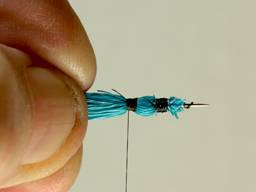 Now move the thread down about another 1/8” and begin to wrap in your next segment. This thread wrap should also be about 1/8”.
Now move the thread down about another 1/8” and begin to wrap in your next segment. This thread wrap should also be about 1/8”.
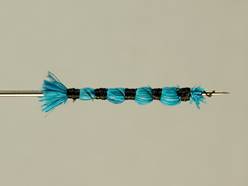 Continue with this procedure until you have tied in five (5) black segment, each about 1/8” in width. Once you have done this, secure your thread. It is now time to trim off the excess tail material, leaving enough to form a small flared tail. I now take this opportunity to trim up the full length of the fly body/tail.
Continue with this procedure until you have tied in five (5) black segment, each about 1/8” in width. Once you have done this, secure your thread. It is now time to trim off the excess tail material, leaving enough to form a small flared tail. I now take this opportunity to trim up the full length of the fly body/tail.
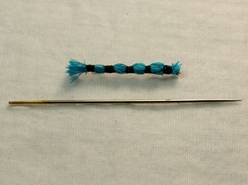 You have now finished tying the ‘off body’ portion of your fly. Grasp it firmly and literally slide it off the sewing needle.
You have now finished tying the ‘off body’ portion of your fly. Grasp it firmly and literally slide it off the sewing needle.
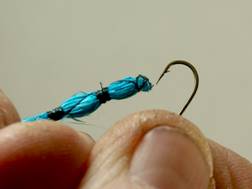 Now take the pointed end of your fly hook; start at the ‘stump end’ of the ‘off body’ and literally thread the hook down the length of the off body.
Now take the pointed end of your fly hook; start at the ‘stump end’ of the ‘off body’ and literally thread the hook down the length of the off body.
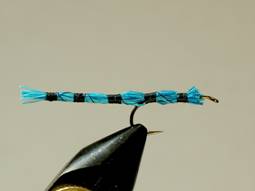 Bring the hook point out just after you have cleared the second segment. Place the hook with the ‘off body’ into your vice.
Bring the hook point out just after you have cleared the second segment. Place the hook with the ‘off body’ into your vice.
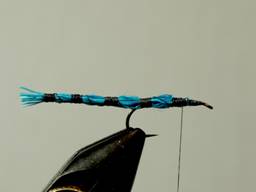 Keep in mind that we want our finished product to be between 32-37 mm. in length. We must allow a small amount of room for the wings and head. Your ‘off body’ will move slightly up and down the shank. You can also adjust the length by trimming off the flared tail if you need to. Once you have made the appropriate adjustments to achieve the correct size then tie in the stump securely to the shank.
Keep in mind that we want our finished product to be between 32-37 mm. in length. We must allow a small amount of room for the wings and head. Your ‘off body’ will move slightly up and down the shank. You can also adjust the length by trimming off the flared tail if you need to. Once you have made the appropriate adjustments to achieve the correct size then tie in the stump securely to the shank.
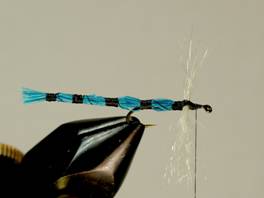 Tie in your polar bear hair wings, spent and sparse. Tie off your thread.
Tie in your polar bear hair wings, spent and sparse. Tie off your thread.
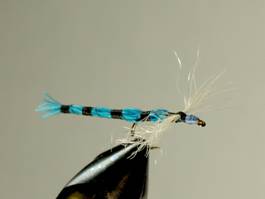 Now tie in the Florescent Blue thread head and tie it off. I place head cement on the head, wings and a drop at each segment. After the cement has dried you can extend the durability of the fly by coating it’s body with lacquer or clear nail polish (that has been thinned with acetone).
Now tie in the Florescent Blue thread head and tie it off. I place head cement on the head, wings and a drop at each segment. After the cement has dried you can extend the durability of the fly by coating it’s body with lacquer or clear nail polish (that has been thinned with acetone).
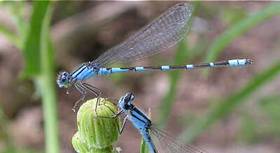 The ‘Tule Bluet’ (Enallagma carunculatum) is one of many pond damsels. It has a wide distribution in all of North America, averaging about 32-37 mm. in size. I dare say there that most everyone has seen them on many occasions. I developed the Bluet Damsel specifically to be a simple and effective pattern. Sometimes we tiers get so carried away with patterns that are more complicated to tie then is needed. The trout is a simple creature with a simple brain. Give him a simple fly.
The ‘Tule Bluet’ (Enallagma carunculatum) is one of many pond damsels. It has a wide distribution in all of North America, averaging about 32-37 mm. in size. I dare say there that most everyone has seen them on many occasions. I developed the Bluet Damsel specifically to be a simple and effective pattern. Sometimes we tiers get so carried away with patterns that are more complicated to tie then is needed. The trout is a simple creature with a simple brain. Give him a simple fly.
The Bluet Damsel is basically a stillwater dry fly pattern that I use on the water during most of the hot summer months, when the damsels are out. Not only does it work for trout, but I’ve had a little success with bass as well.
See you on the water…..
copyright 2010©Deschaine
 Tom is a retired biology teacher from Michigan.
Tom is a retired biology teacher from Michigan.
He now maintains a modest website which specializes
in information about old Michigan Dry Flies.
www.michigandryflies.net
For more great info, check out:
Beginning Fly Tying | Intermediate Fly Tying | Advanced Fly Tying.
